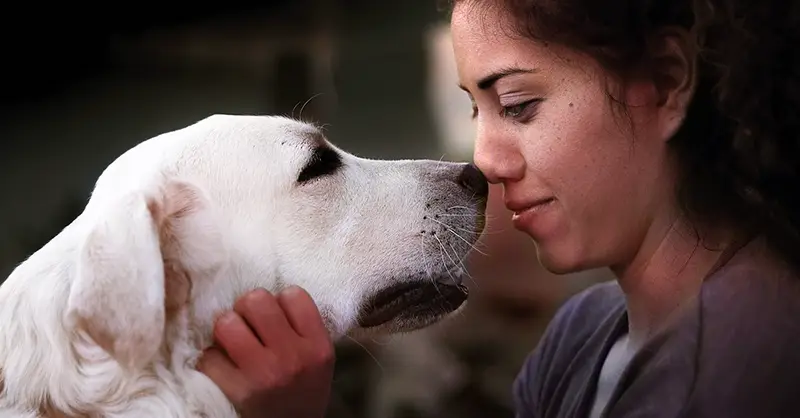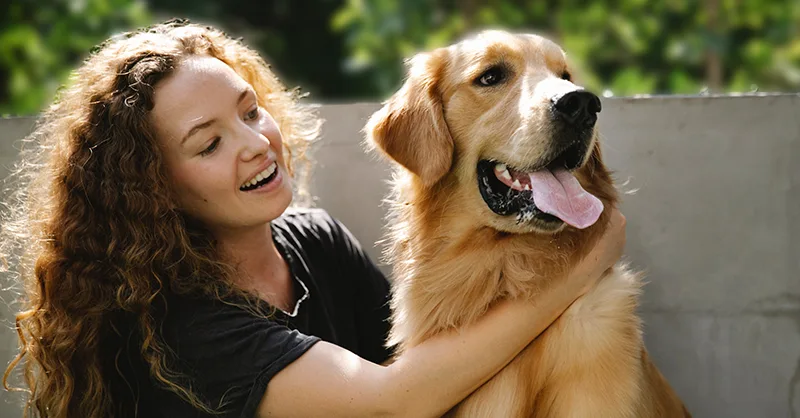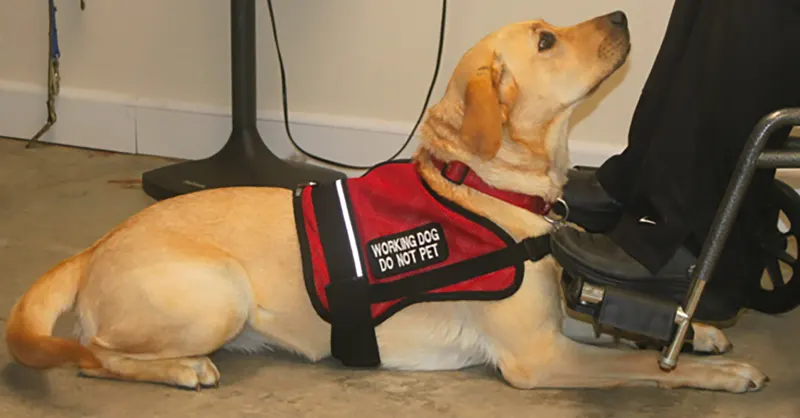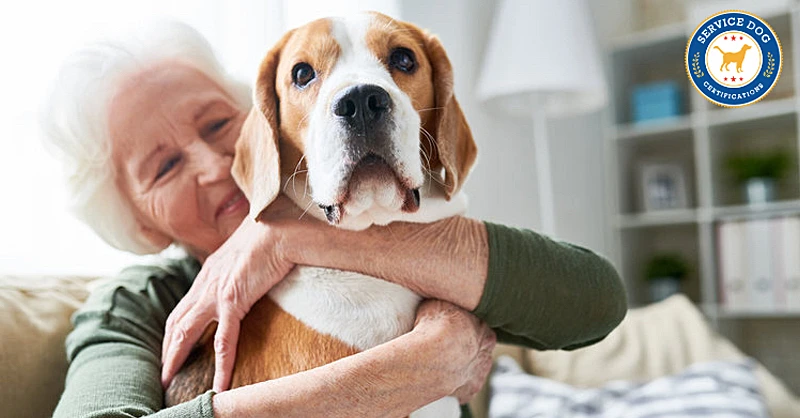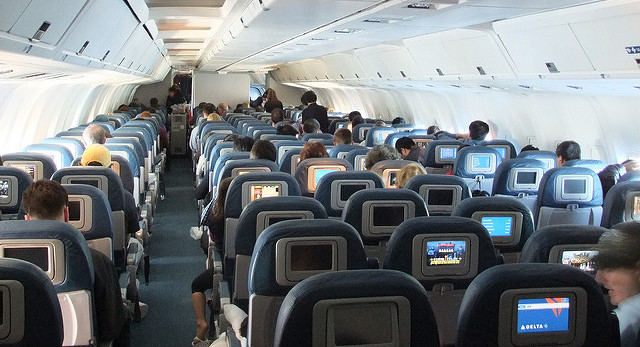Archive for the ‘Service Dog Tips’ Category
Have you ever wondered what a service dog can do and what steps are needed to acquire one? A service dog is a canine trained to perform tasks for a person with a physical or mental disability. The job completed by the service dog has to be directly related to the handler’s condition. In this article, we will explain in detail everything you need to know on how to get a service dog.
Steps to Get a Service DogThere are a few steps and considerations involved in selecting, training, and utilizing a service dog:
Select a dog to be your service animal Train your service dog, on your own or with professional help Make sure your service dog is ready for public environments Understand your rights as a service dog owner Understand how to register your service dog, use equipment and respond to public inquiries Step # 1 – Select a dog to be your service animalThe type of dog you choose to be a service animal depends on your physical and mental health needs. Large dogs (like Golden Retrievers, Labrador Retrievers, and German Shepherds) and smaller breeds (such as Poodles) work as useful service dogs for their owners. Larger service dogs are more appropriate for physically demanding tasks such as pulling a wheelchair or traversing through crowded streets. However, smaller service dogs also have advantages, such as being easier to handle for some owners and requiring less space.
The temperament of the dog and its personality are also important considerations. While stereotypes and general characteristics about a breed may be helpful to know, the specific personality traits and quirks of a dog can vary widely within breeds. That is why it is also important to spend some time with the dog you are considering adopting to get a sense of its character.
A service dog should have a stable temperament, particularly if the dog will be working in stressful environments such as crowded areas or if the service dog will need to respond to crises. A service dog should also be alert, responsive, and highly receptive to training. No matter what breed of dog is selected, a service dog should maintain its attention on its handler. It needs to be under control at all times, tune out unnecessary distractions (especially in busy, noisy environments), and be consistently dependable to perform the tasks they were trained for.
Selecting the right dog as service dog can be time-consuming, but finding a dog with the right temperament and physical abilities is key to getting a service dog.
Service Dog Certifications
Training a service dog is a time-consuming and substantial investment. Service dog owners will want to ensure to the extent possible that the dog they adopt is healthy. Young canines with a clean bill of health are ideal choices for handlers, as they may respond better to training and have a greater lifespan than an older dog. Older dogs, however, can also make great service dogs, especially ones with prior training. It’s important to recognize that it may be more difficult to break bad habits in older dogs and that an older dog will have a shorter lifespan.
It’s also important to consider how much maintenance a dog may need. For example, a dog that is constantly shedding and requires routine cleanup may be less favorable for some owners than a dog that sheds less and is hypoallergenic. Some dogs also require a high degree of activity and mental stimulation, while others are content with being more sedentary.
A service dog is an incredibly worthwhile investment but requires time, resources, and long-term commitment. Choosing the right dog for the job from the outset is important for service dog handlers, but perhaps more important is the training the service dog receives, which we will discuss in the next step.
A service dog may take efforts to get but can benefit the owner’s life in several ways. Step # 2 – Train your service dog, on your own or with professional help.The essence of a service dog is that it must be trained to do work or perform tasks for its handler. Training your service dog can be done on your own or with a professional trainer. There is no official qualification program under the ADA for service dogs. Owners of service dogs fully have the right to train their service dogs on their own, and there is no requirement to use a professional training program.
If you have the skills, time, and patience to train your dog, it can be a wonderfully rewarding experience. The training process itself can help strengthen the bond between the handler and their service dog. For those who need help, there are professional trainers available and organizations that provide guidelines for proper service dog training. For example, one organization recommends a minimum of 120 hours of training over a period of six months or more, with at least 30 hours dedicated to public excursions that will train the service dog to work effectively in real-world settings.
In addition to being trained for the tasks required by its handler, a service dog must master basic commands and be well-behaved in all settings.
Service Dog Certifications
A service dog should have the following qualities: No aggressive behavior towards other people or animals (i.e., no biting, growling, lurching, chasing or excessive barking). No begging for food or attention from other people while working. Ability to be controlled calmly on a leash without tugging or darting when distracted. No sniffing behavior while working. No hyperactivity or excited behaviors Ability to tolerate novel stimuli in busy environments. No unruly behavior in public settings. No relieving itself in public places unless given permission to do so by its handler.Whether you decide to train your service dog on your own or use professional help, the important thing is that your service animal is fully trained to perform the tasks required by your disability.
Prospective service dog owners should be aware that under ADA rules, the service dog must already be fully trained before it can accompany the owner in public settings. That means a service dog in training is not yet considered a service dog. However, some State and local rules provide protections for service animals in the process of completing their training.
Step # 3 – Make sure your service dog is ready for public enviroments.After your service dog has been trained, you will want to ensure that it is ready to handle real-world situations. Training a service dog at home is fine, but those “controlled environments” cannot replicate the unpredictability of public settings.
Some organizations provide tests that can help determine whether your service dog is ready to perform in real-world settings. And some trainers and programs can provide public access tests to determine whether your service dog is ready. However, these tests do not confer any “official” status on a service animal and are completely optional for handlers.
As a service dog can accompany its owner everywhere, it must be trained to master any situation in any public environment.
Service Dog Certifications
A service dog owner will want to make sure their dog has been trained to have certain abilities that will help it master being in public environments.
Test your service dog ability to do the following: Tune out distractions in busy and noisy environments while on duty. Safely navigate streets that have vehicular and pedestrian traffic. Navigate tight quarter environments such as store aisles and restaurants. Behave appropriately when approached by children. Remain calm in the presence of other dogs and animals. Not become easily distracted by objects on the ground or food.Before bringing a service dog into a public setting, it’s also important to ensure the handler is also adequately prepared. Under ADA rules, a service dog must be under the control of its handler at all times. The handler should be able to control the service dog using voice, signal, or other methods, recover control if a leash is dropped, and deal with inquiries from other people and staff members in public establishments regarding the service dog.
Step # 4 – Understand your rights as a service dog owner.Under the ADA, a service dog must be allowed in all areas where the public can go. This applies to businesses and public property. Some examples of venues where service dogs must be allowed are:
Restaurants Theaters Malls and retail outlets Grocery stores Hospitals Hotels Public transportation Gyms, bowling alleys, arenas, stadiums and other entertainment facilities Libraries and schoolsFacilities must allow service dogs even in cities where local rules prohibit the service dog’s particular breed. An establishment may only exclude a service animal if it behaves in a way that poses a direct threat to the health and safety of others or is not under the control of the handler. That is another reason why it is so important that your service animal is appropriately trained and capable of being kept under control.
A service dog is a vital part of its owners’ well-being and enjoys protection by various federal and state laws.
Service Dog Certifications
According to the Air Carrier Access Act, service dogs also have the right to travel with their handlers in the airplane cabin, free of charge. Service dogs and their handlers also have certain housing rights under the Fair Housing Act and various State laws. These housing protections allow handlers to live with their service dogs, even in buildings that ban animals. Landlords are not allowed to charge a fee or pet deposit for a service dog.
Step #5 – Understand how to register your service dog, use equipment and respond to public inquiriesWhen out in public, service dog owners have a right to privacy regarding their disability. If it is obvious to an observer that the dog is a service animal, the staff at an establishment cannot bother the handler about their disability or need for the service dog.
However, in situations where it is not immediately apparent that the dog is a service animal (for example, if the service dog is used for a psychiatric condition or only during sporadic emergencies), the staff may only ask two questions:
Is the dog a service animal required because of a disability? What work or task has the dog been trained to perform?Third parties are not entitled to any further information. Staff members cannot request documentation for the service dog, ask that the dog demonstrate its ability to perform its task, or ask questions regarding the handler’s disability. Disability laws were designed, so that service dog handlers do not have to undergo invasive scrutiny or questioning.
Service dog owners commonly use accessories such as vests, IDs, tags, harnesses, and service dog certification to signal to members of the public that their dog is a working service animal. These accessories are not mandatory and do not by themselves certify that a dog is a service animal, but they are useful and popular with service dog owners.
Service dog accessories and registration IDs are not required but can help owners communicate their need for the service dog’s presence in public.
Service Dog Certifications
Registering your service dog with an organization and obtaining vests, ID cards, harnesses, and other accessories is an effective way to inform the public that your animal companion is a service dog. These tools can help prevent intrusive inquiries about your service dog. They also help warn members of the public that they should not play with, pet, or feed your service dog while it is on duty. Many service dog owners who are anxious about being interrogated about their need for their service dog find these tools to be useful.
Service Dog TasksService dogs are employed to help with a wide variety of disabilities. Below are a few examples of the important duties that service dogs are called upon to perform for their handlers:
Helping the blind navigate public areas. Pulling a disabled person’s wheelchair. Reminding someone with a mental illness to take their medication. Providing pressure therapy to calm someone in an agitated psychiatric state, such as a severe anxiety attack or an episode relating to post-traumatic stress disorder. Opening doors for someone with limited mobility. Alerting someone to an oncoming health issue such as a drop in blood sugar. Preventing the handler from harming themselves while experiencing a seizure by protecting their head. Picking up dropped items, and retrieving/carrying items such as mail for someone with mobility issues.Regardless of the work these amazing dogs perform, these canine companions are vital to the individuals that need them. Under the Americans with Disabilities Act, service dogs are not considered pets and have special legal rights. Under the ADA, businesses and state and local governments must allow service dogs to accompany their handlers in all areas of the premises where the public is allowed. Any grocery store, hotel, beach, or restaurant open to the public must allow a handler to be accompanied by their service dog.
Service Dogs Are Not to Be Confused with Emotional Support AnimalsEmotional support animals have more limited rights than service dogs. Owners of emotional support animals have the right to be accompanied in their homes under the Fair Housing Act. Unlike service dogs, ESAs do not require any special training and provide support to their owners by their mere presence for mental and emotional health issues.
Many people with psychiatric conditions utilize service dogs, but for some people who suffer from mental or emotional health issues, an emotional support animal is more appropriate. An ESA requires an ESA letter from a licensed counselor, therapist, or doctor.
The main difference between service dogs and emotional support animals is that service dogs require specialized training and have much greater rights to accompany their owners in public places.
Service Dogs Play an Indispensable Role in the Lives of Disabled PeopleOwners of service animals enjoy many rights under the ADA and other disability laws. Service dog owners benefit from their service dogs in many ways. Prospective service dog owners should carefully consider these steps mentioned in this article before adopting and training a service dog. Owning a service dog is a major responsibility that requires dedication and commitment. But service dog owners will agree that the rewards are worth the effort.
Unable to train your dog as a service dog?You may be interested in an Emotional Support Animal instead. ESAs do not require specific training and have access to no-pet apartments. Click here to learn more about ESAs.
If you don’t have your own vehicle, then you may have encountered some difficulty in getting a ride with your dog in tow. Some cab drivers have the right to refuse you service based on personal reasons when it comes to pets riding in their car.
Lyft is trying to take the hassle out of this experience. Is Lyft dog-friendly? The answer to this question is dependant on the driver.
In this post, we will cover some important facts when it comes to catching a Lyft with your dog.
Service Dogs Are Allowed on LyftIt’s a law that you cannot discriminate against a person that needs the help of a Service Dog. If you are disabled, then the Lyft company must find you a driver that does not have an issue with a canine in their cab.
However, be aware that under the definition of “service” your dog must be trained to help you with a task that you cannot do for yourself. This could include (but is not limited to) opening doors, picking up dropped items or alerting you to an oncoming medical condition.
You do not have to inform the driver that you will be traveling with a Service Dog as this goes against your legal rights.
Traveling With Pets Through LyftWhen traveling with a pet (a non-service animal) there are a few basic steps to making your experience a pleasant one through the Lyft company.
Step # 1 – Tap the App
Open the Lyft app on your cellular device and tap it to place the call. The “Request a Lyft” icon will appear to answer your call. The nearest driver will be there shortly to assist you. You will also be given some necessary information about the driver (car they are driving, driver’s name, and contact number).
Step # 2 – Inform the Driver
Since the decision to pick up pets is left up to the individual driver, you will need to inform yours that you will be traveling with a pet. If the driver has an issue with your dog (i.e. allergies or a fear), then you can cancel the ride and call for another driver to assist you.
Be sure to be honest with your driver concerning the size and weight of your canine companion. Some drivers may not take issue with a smaller breed.
Step # 3 – Be Prepared
As a common courtesy, bring a towel for your dog to sit on (if he is not a lap dog). This helps control your dog’s shedding onto the seat. If your dog gets nervous in cars, then you may want to kennel him for the ride. Most driver’s do not have a problem transporting animals that are contained.
Lastly, be sure to leave your driver a generous tip. Lyft does not require their drivers to transport no-service dogs, so show your appreciation by giving them a little extra for their trouble.
Conclusion
Lyft is making every effort to assist their clients with pets, but are also taking into consideration their drivers that have an issue with dogs and other pets. For the sake of both employee and customer, Lyft has left the decision to transport pets in the hands of their drivers.
Be sure to inform your driver of your pet when you order the Lyft and follow some courtesy practices to ensure your ride goes off without a hitch.
Delta carries approximately 250,000 Service and Emotional Support Animals each year. However, as of March 01, 2018, they are tightening their policy for these working animals in an effort to reduce “misbehavior” by dogs (and other creatures). Although the carrier is required by law to admit Service animals and ESA’s into the cabin of the craft, they can and are putting extra rules into place.
What is the new policy? How does this affect those with disabilities that need a Service Dog? Read on for the important facts you will need to know before you book your next flight with Delta.
What is a Service Animal?
There is a difference between a Service Animal and an Emotional Support Animal. Service animals are typically dogs that have been trained to perform a specific task for an individual with a disability. This can be any number of things from picking up dropped items to opening doors, to alerting the person to an oncoming medical situation.
The Emotional Support Animal, on the other hand, is there only to provide the individual with comfort and support. These can be of any species of animal and do not need to be trained for a specific service, other than comfort.
Why is Delta Changing Their Service Dog Policy?Delta has seen a surge of 150 percent in service animals (that by Federal law must be allowed to fly uncaged and at no additional cost to the passenger) since 2015. However, there have been incidences of customers “attempting to fly with comfort turkeys, gliding possums known as sugar gliders, snakes, spiders and more.”
This has increased the complaints from Delta passengers concerning allergies, and other disturbances, as well as abuse to the Service Dog policy, with some of these clients just trying to fly their pets for free.
With an average of more than 200 service animals and 500 support animals flying on a daily basis, and the fact that in-flight incidences with these types of animals have risen 84 percent since 2016, Delta felt the need to change-up their policies.
Delta said; More untrained animals are being brought onto planes, where they urinate, defecate, bark, growl, lunge and exhibit other behavior uncommon among companions that are properly taught.”
What is the New Delta Policy Regarding Service Dogs and Emotional Support Animals?As of the first of March 2018, Delta will require all passengers with service dogs or emotional support animals to submit proof of health or vaccinations. This will have to be done through Delta’s website 48 hours before flight time.
Those customers requiring an ESA or Psychiatric Service Animal must (in addition to the health record) sign a document stating the animal’s “ability to behave in the cabin or risk being barred from boarding or removed from the plane.”
However, Delta does not require any proof that the animal has graduated from obedience school. But be aware that you will need to provide a letter prepared and signed by your licensed mental health professional explaining why you need an ESA to accompany you on the flight.
Where can I get the new Delta service dog forms?
Before you fly with Delta, be sure to visit their website to download the proper forms you will need before your flight. The new Delta service dog travel forms can be accessed here.
Behaviors Delta Will Not TolerateWith these stricter policies, Delta urges those folks traveling with animals in the cabin of the aircraft to have their “working” animals under control at all times. Behaviors that will not be tolerated include;
Growling Jumping on passengers Relieving themselves in the gate area or cabin Barking excessively, not in response to a handler’s need or distress Eating off seat back tray tablesDelta reserves the right to refuse transportation for any animal exhibiting unruly behavior.
Conclusion
If you are planning a trip on Delta airlines and need a Service or an Emotional Support Animal, be sure to have your animal’s health or proof of vaccination certificate. If you are traveling with an ESA or psychiatric service animal, you will also need a note from your mental health professional stating your need for the animal. Be sure to visit Delta’s website for further downloads and let them know you will be traveling with a “working” animal 48 hours prior to your flight. To register your service animal and receive your service dog certification, complete the registration in the link below.
